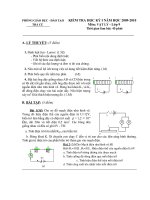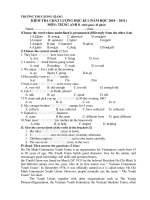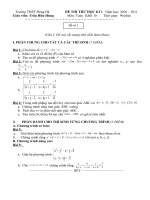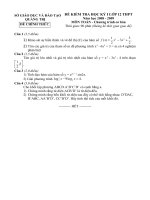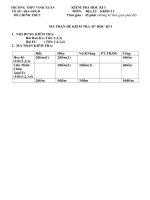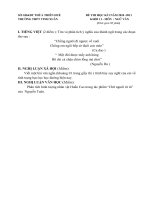- Trang chủ >>
- THPT Quốc Gia >>
- Ngoại Ngữ
de thi hoc ky 1 nam 2017mon tieng anhthpt truc ninh bnam dinh file word co loi giai
Bạn đang xem bản rút gọn của tài liệu. Xem và tải ngay bản đầy đủ của tài liệu tại đây (116.78 KB, 15 trang )
Đề thi học kỳ 1 năm 2017_THPT Trực Ninh B_Nam Định
Môn: Tiếng Anh
Mark the letter A, B, C or D on your answer sheet to indicate the sentence that is closest in
meaning to each of the following questions
Question 1: We narrowly avoided an accident with a coach by managing to stop quickly
A. The gap we had left between us and the coach was too narrow to avoid an accident.
B. It was such a narrow road that we nearly had an accident with a coach.
C. If the coach hadn’t stopped so suddenly, we wouldn’t have had the accident.
D. We would have had a collision with a coach if we hadn’t come to a stop so swiftly.
Question 2: She started working as a teach for English ten years ago.
A. She had worked with a teacher of English for ten years.
B. She has been working as a teacher of English for ten years.
C. She had been working as a teacher of English for ten years.
D. She has worked with a teacher of English for ten years.
Question 3: “I would take the job if I were you”, said my friend.
A. My friend told me to take the job.
B. My friend asked me to take the job.
C. My friend advised me to take the job.
D. My friend ordered me to take the job.
Read the following passage and mark the letter A, B, C, or D on your answer sheet to
indicate the correct answer to each of the questions from 1 to 6.
As computer use becomes more common, the need for security is more important than
ever. One of the greatest security threats in the online world is computer hacking.
Computer hacking is the unauthorized access to a computer or network of computers.
Hackers are people who illegally enter systems. They may alter or delete information, steal
private information, or spread viruses that can damage or destroy files. But how exactly can a
hacker get into a system to do these things?
Most hackers use information called protocols that are built into computer software.
These protocols allow computer to interact with one another. Protocols are sort of like
computer police officers. When a computer connects to another system, the protocols check
to see if the access is valid. The protocols can also determine how much information can be
shared between the two systems. Hackers can manipulate the protocols to get unlimited
access to a computer system.
In fact, just the act of entering a computer network is considered hacking. This is
commonly called passive hacking. Passive hackers get a rush from just being able to access a
Trang 1 – Website chuyên đề thi thử file word có lời giải
challenging system like a bank of military network. Another kind of hacker tries to do
damage to a system. After hacking into systems, these hacker release viruses or alter, delete,
or take information. Known as active hackers, they are, by far, the more dangerous of the
two.
The easiest way to protect a system is with a good password. Long and unusual
passwords are harder for hackers to guess. For even greater security, some online services use
“password-plus” systems. In this case, users first put in a password and then put in a second
code that changes after the user accesses the site. Users either have special cards or devices
that show them the new code to use the next time. Even if a hacker steals the password, they
won’t have the code. Or if the hacker somehow gets the code, they still don’t know the
password.
Question 4: What is NOT considered hacking?
A. Turning on a private computer.
B. Spreading viruses.
C. Illegally entering systems.
D. Altering or deleting private information.
Question 5: How can hackers get access to a computer system?
A. Change security programs.
B. Manipulate the protocols.
C. Spread viruses.
D. Make a new password.
Question 6: The word “they” in the fourth paragraph refers to _________
A. computer systems. B. passive hackers.
C. computer viruses.
D. active hackers.
Question 7: Why are active hacker probably considered more dangerous than passive ones?
A. Active hackers are more skilled.
B. Passive hackers are caught more easily.
C. Passive hackers have more intense personalities.
D. Active hackers do damage.
Question 8: What does “plus” in “password-plus” in the passage probably mean?
A. fast
B. long
C. danger
D. extra
Question 9: What is the main idea of this passage?
A. Good ways to stop hackers.
B. Hackers and computer security.
C. Famous hackers.
D. Funny things hackers do.
Make the letter A, B, C or D on your answer sheet to indicate the most suitable response
to complete each of the following exchanges
Question 10: Two friend Tina and Mary are talking about Mary’s new shirt.
- Tina: “That’s a very nice skirt you’re wearing, Mary!”
Trang 2 – Website chuyên đề thi thử file word có lời giải
- Mary: “____________”
A. I like you said so.
B. It’s nice of you to say so.
C. Thanks, but I’m so afraid.
D. That’s all night.
Question 11: Jenny is talking to Sunsan after school
A. We don’t have any film.
B. Let’s take the seat.
C. I’ve seen the film already.
D. You went to theatre.
Mark the letter A, B, C or D on your answer sheet to indicate the word that differs from
the other three in the position of primary stress in each of the following questions
Question 12:
Question 13:
A. threaten
A. memory
B. support
B. interview
C. award
C. confidence
D. provoke
D. employment
Mark the letter A, B, C or D on your answer sheet to indicate the word(s) OPPOSITTE
in meaning to the underlined word(s) in each of the following questions.
Question 14: I find it hard to work at home because there are too many distractions
A. unawareness
B. unconcern
C. attention
D. carelessness
Question 15: These machines are order models and have to be operated by hand.
A. manually
B. mechanically
C. automatically
D. spiritually
Mark the letter A, B, C or D on your answer sheet to indicate the word(s) CLOSEST in
meaning to the underlined word(s) in each of the following questions.
Question 16: As children we were very close, but as we grew up we just drifted apart.
A. became less sympathetic
B. became less serious
C. became less friendly
D. became less childlike
Question 17: Magazines were the first visual medium before the advent of television
A. acceptance
B. achievement
C. arrival
D. spiritually
Mark the letter A, B, C or D on your answer sheet to indicate the underlined part that
needs correction in each of the following questions.
Question 18: Her passion for helping people have motivated her to found her own charity
organization
A. found
B. for
C. organization
D. have motivated
Question 19: You should stop wasting your time and doing something useful instead
A. instead
B. wasting
C. and doing
D. something
Trang 3 – Website chuyên đề thi thử file word có lời giải
Question 20: Life that we know it is based on the element carbon
A. based on
B. element
C. it is
D. that
Read the following passage and mark the letter A, B, C or d on your answer sheet to
indicate the correct answer to each of the questions from 1 to 9
For more than six million American children, coming home after school means
coming back to an empty house.Some deal with the situation by watching TV. Some may
hide. But all of them have something in common. They spend part of each day alone. They
are called “latchkey children”. They are children who look after themselves while their
parents work. And their bad condition has become a subject of concern.
Lynette Long was one principal of an elementary school. She said, “We had a school
rule against wearing jewelry. A lot of kids had chains around their necks with keys attached. I
was constantly telling them to put the keys inside shirts. There were so many keys, it never
came to my mind what they meant. Slowly, she learned that they were house keys.
She and her husband began talking to the children who had keys. They learned of the
effect working couples and single parents were having on their children. Fear was the biggest
problem faced by children at home alone. One in three latchkey children the Longs talked to
reported being frightened. Many had nightmares and were worried about their own safety.
The most common way latchkey children deal with their fears is by hiding. They
made hide in a shower stall, under a bed or in a closet. The second is TV. They often turn the
volume up. It’s hard to get statistics on latchkey children, the Longs have learned. Most
parents are slow to admit that they leave their children alone.
Question 21: What is the topic of the passage?
A. Kids without parents
B. Children’s activities
C. Lonely children
D. Latchkey children
Question 22: The phrase “an empty house” in the passage mostly means ___________
A. a house with no furniture
B. a house with nothing inside
C. a house with no people inside
D. a house with too much space
Question 23: One thing that the children in the passage share is that ___________
A. they spend part of each day alone
B. they are from single-parent families
C. they all wear jewelry
D. they all watch TV
Question 24: “Latchkey children” in the passage means children who ___________
A. look after themselves while their parents are not at home
B. close doors with keys and watch TV by themselves
Trang 4 – Website chuyên đề thi thử file word có lời giải
C. like to carry latches and keys with them everywhere
D. are locked inside houses with latches and keys
Question 25: Lynette Long learned of latchkey children’s problems by _________
A. delivering questionnaires
B. visiting their homes
C. interviewing their parents
D. talking to them
Question 26: Why did a lot of kids have chains around their necks with keys attached?
A. They would use the keys to enter their houses when they came home
B. They had to use the keys to open school doors
C. Schools didn’t allow them to wear jewelry, so they wore keys instead
D. They were fully grown and had become independent
Question 27: The main problem of latchkey children is that they _________
A. watch too much television during the day
B. are also found middle-class families
C. suffer a lot from fear
D. are growing in numbers
Question 28: What is the most common way for latchkey children to deal with fears?
A. Hiding somewhere
B. Lying under a TV
C. Having a shower
D. Talking to the Longs
Question 29: It’s difficult to find out the number of latchkey children because __________
A. most parents are reluctant to admit that they leave their children alone
B. they hide themselves in shower stalls or under beds
C. they do not give information about themselves for safety reasons
D. there are too many of them in the whole country
Mark the letter A, B, C or D on your answer sheet to indicate the word whose
underlines part differs from the other three in pronunciation in each of the following
questions
Question 30:
Question 31:
A. attitude
A. worships
B. nature
B. expands
C. ancient
C. maintains
D. capable
D. believes
Read the following passage and mark the letter A, B, C or D on your answer sheet to
indicate the correct word or phrase that best fits each of the numbered banks from 32 to
36.
School exams are, generally speaking, the first kind of tests we take. They find out
(32) _____ much knowledge we have gained. But do they really show how intelligent we
Trang 5 – Website chuyên đề thi thử file word có lời giải
are? After all, isn’t it a fact that some people who are very successful academically don’t have
any common sense?
Intelligence is the speed at which we can understand and react to new situations and it
is usually tested by logic puzzles. (33) _____ scientists are now preparing advanced computer
technology that will be able to “read” our brains, for the present, tests are still the most
popular ways of measuring intelligence.
A person’s IQ is their intelligence (34) _____is measured by a special test. The most
common IQ tests are run by Mensa, an organization that was founded in England in 1946. By
1976 it had 1,300 members in Britain. Today there are 44,000 Britain and 100,000
worldwide, (35) _____ in the US.
People talking the tests are judged in relation to an average score of 100, and those
(36) _____ score over 148 are entitled to join Mensa. This works out at 2% of the population.
Anyone from the age of six can take the tests. All the questions are straightforward and most
people can answer them if allowed enough time. But that’s the problem – the whole point of
the tests is that they’re against the clock.
Question 32:
Question 33:
Question 34:
Question 35:
Question 36:
A. what
A. although
A. how
A. enormously
A. whom
B. how
B. because
B. as
B. considerably
B. which
C. why
C. despite
C. so
C. highly
C. that
D. which
D. until
D. that
D. mainly
D. who
Mark the letter A, B, C or D on your answer sheet to indicate the correct answer to each
of the following questions
Question 37: Old people are often looked _____ by their children when they got older.
A. for
B. up
C. after
D. into
Question 38: She didn’t get _____ very well with the roommate.
A. off
B. on
C. in
D. through
Question 39: Kate asked Janet where _____ the previous Sunday.
A. has she been
B. she had been
C. had she been
D. she has been
Question 40: The charity aims to _____ food and shelter for underprivileged in the remote
areas of the country
A. present
B. assist
C. provide
D. offer
Question 41: Her mother is _____ nurse. She works at a large hospital
A. as
B. a
C. an
D. the
Trang 6 – Website chuyên đề thi thử file word có lời giải
Question 42: The woman sitting next to me on the plane was very nervous. She _____
before.
A. hasn’t flown
B. hadn’t flown
C. wasn’t trying
D. didn’t try
Question 43: We need to promote a lifestyle that is _____ to the environment.
A. friendly
B. friend
C. friendship
D. friendliness
Question 44: At school, children learn a lot of _____ such as maths, biology, history,
geography and English.
A. subjects
B. topics
C. lessons
D. objects
Question 45: The child that we caught _____ was made to stand in the corner of the
classroom.
A. misbehavior
B. misbehave
C. behaving
D. misbehaving
Question 46: I can’t concentrate _____ my work, because of all the noise the builders are
making.
A. to
B. on
C. in
D. at
Question 47: Widespread forest destruction _____ in this particular area.
A. could have been
B. must have seen
C. ought to see
D. can be seen
Question 48: Your last job was a tourist guide, _____ it?
A. isn't
B. doesn't
C. didn't
D. wasn't
Mark the letter A, B, C or D on your answer sheet to indicate the sentences that best
combines each pair of sentences in the following questions.
Question 49: She wrote the text. She selected the illustration as well.
A. If she had written the text, she would have selected the illustration
B. In order to select the illustration, she had to write the text
C. She not only wrote the text but also selected the illustration
D. The text she wrote was not as good as illustration she selected
Question 50: The plan may be ingenious. It will never work in practice.
A. The plan may be too ingenious to work in practice
B. Ingenious as it may be, the plan will never work in practice
C. Ingenious as may be the plan, it will never work in practice
D. The plan is as impractical as it ingenious
Đáp án
1-D
2-B
3-C
4-A
5-B
6-D
7-D
8-D
9-B
Trang 7 – Website chuyên đề thi thử file word có lời giải
10-B
11-C
21-D
31-A
41-B
12-A
22-C
32-B
42-B
13-D
23-A
33-A
43-A
14-C
24-A
34-D
44-A
15-C
25-D
35-D
45-D
16-C
26-A
36-D
46-B
17-C
27-C
37-C
47-D
18-D
28-A
38-B
48-D
19-C
29-A
39-B
49-C
20-C
30-A
40-C
50-B
LỜI GIẢI CHI TIẾT
Question 1: Đáp án D
Dịch nghĩa : Chúng tôi thoát khỏi vụ tai nạn với chiếc xe tải trong gang tấc bằng việc dừng
lại nhanh chóng.
A.Khoảng cách giữa chúng tôi và chiếc xe tải quá hẹp để tránh khỏi tai nạn
B. Con đường quá hẹp đến nỗi chúng tôi gần không thể tránh khỏi tai nạn
C. Nếu chiếc xe tải không dừng lại đột ngột, chúng tôi có thể đã không bị tai nạn
D. Chúng tôi có thể đã va đập với chiếc xe tải nếu chúng tôi không dừng lại ngay lập tức.
Question 2: Đáp án B
Giải thích : Cô ấy bắt đầu dạy tiếng Anh 10 năm trước.
A.Cô ấy đã làm việc với 1 giáo viên tiếng Anh trong 10 năm
B. Cô ấy làm việc như 1 giáo viên tiếng Anh trong 10 năm
C. Cô ấy đã làm việc như 1 giáo viên tiếng Anh trong 10 năm
D. Cô ấy làm việc với 1 giáo viên tiếng Anh trong 10 năm
Question 3: Đáp án C
Giải thích : “Nếu là bạn, tôi đã nhận công việc này.”, bạn tôi nói.
A.Bạn tôi bảo tôi nhận công việc này
B.Bạn tôi yêu cầu tôi nhận công việc này
C.Bạn tôi khuyên tôi nhận công việc này
D.Bạn tôi ra lệnh cho tôi nhận công việc này
Question 4: Đáp án A
Giải thích : Đáp án nằm ở : “Hackers are people who illegally enter systems. They may alter
or delete information, steal private information, or spread viruses that can damage or destroy
files”
(Những kẻ đánh cắp dữ liệu là những người truy cập trái phép vào hệ thống. Họ có thể thay
đổi hoặc xoá thông tin, đánh cắp thông tin cá nhân, hoặc lan truyền virus có thể phá huỷ hoặc
huỷ diệt các tệp tin)
Dịch nghĩa : Điều nào sau đây không được coi là đánh cắp dữ liệu ?
A. Bật 1 máy tính cá nhân
B. Lan truyền virus
Trang 8 – Website chuyên đề thi thử file word có lời giải
C. Truy cập trái phép hệ thống
D. Thay đổi hoặc xoá dữ liệu cá nhân
Question 5: Đáp án B
Giải thích : đáp án nằm ở : “Most hackers use information called protocols that are built into
computer software.”(Phần lớn hacker sử dụng thong tin gọi là các định ước được thiết lập
trong phần mềm máy tính. )
Dịch nghĩa : Hacker truy cập vào 1 hệ thống máy tính như thế nào ?
A.Thay đổi phần mềm bảo mật
B. Điều khiển các định ước
C. Lan truyền virus
D. Tạo mật khẩu mới.
Question 6: Đáp án D
Dịch nghĩa : từ “they” ở đoạn 4 ám chỉ __________.
Hệ thống máy tính
B. Hacker bị động
C. Virus máy tính
D. Hacker chủ động
Question 7: Đáp án D
Giải thích : đáp án nằm ở : “After hacking into systems, these hacker release viruses or alter,
delete, or take information. Known as active hackers, they are, by far, the more dangerous of
the two.”
(Sau khi xâm nhập được vào hệ thống, những hacker này thả ra những virus hoặc thay đổi,
xoá, hoặc lấy thông tin. Được biết đến như là những hacker chủ động, họ, còn nguy hiểm hơn
2 loại trên nhiều.)
Dịch nghĩa : Tại sao hacker chủ động có thể được coi là nguy hiểm hơn so với hacker bị động ?
A.Hacker chủ động chuyên nghiệp hơn
B. Hacker bị động dễ bị bắt hơn
C. Hacker bị động có nhiều tính cách
D. Hacker chủ động phá huỷ dữ liệu.
Question 8: Đáp án D
Giải thích : plus = extra (adj) : thêm
Dịch nghĩa : từ “plus” trong “password-plus” trong bài văn có thể có nghĩa là :
A.Nhanh
B. Dài
C. Nguy hiểm
D. Thêm
Question 9: Đáp án B
Trang 9 – Website chuyên đề thi thử file word có lời giải
Dịch nghĩa : Ý chính của bài văn là :
A.Những cách hay để ngăn chặn hacker
B. Những kẻ cắp dữ liệu và bảo mật máy tính
C. Những kẻ cắp dữ liệu nổi tiếng
D. Những điều thú vị mà kẻ cắp dữ liệu thường làm.
Question 10: Đáp án B
Dịch nghĩa : Tina : “Mary, chiếc váy cậu mặc thật là xinh ~”
Mary : “Bạn thật là dễ thương khi nói mình như vậy ~”
Question 11: Đáp án C
Giải thích : Jenny : “Đi coi phim tối nay nào !”
Susan : “Tớ coi bộ phim đó rồi =.=”
Question 12: Đáp án A
Giải thích : Ở đáp án A trọng âm rơi vào âm tiết thứ nhất, ở các đáp án khác trọng âm rơi vào
âm tiết thứ 2.
A. threaten ['θretn]
B. support [sə'pɔ:t]
C. award [ə'wɔ:d]
D. provoke [prə'vouk]
Question 13: Đáp án D
Giải thích : Ở đáp án D trọng âm rơi vào âm tiết thứ 2, ở các đáp án khác trọng âm rơi vào âm
tiết 1.
A. memory ['meməri]
B. interview ['intəvju:]
C. confidence ['kɔnfidəns]
D. employment [im'plɔimənt]
Question 14: Đáp án C
Giải thích : attention = focus = concentration : sự tập trung >< distraction : sự làm cho
phân tâm
Question 15: Đáp án C
Giải thích : by hand : làm tay, làm thủ công >< automatically : làm bằng máy móc
Question 16: Đáp án C
Giải thích : to drift apart : chia ly, chia xa
Dịch nghĩa : Khi còn nhỏ chúng tôi rất thân nhau, nhưng khi lớn lên chúng tôi không còn liên
lạc với nhau nữa.
Trang 10 – Website chuyên đề thi thử file word có lời giải
Question 17: Đáp án C
Giải thích : advent (n) = arrival (n) : sự đến, sự tới
Question 18: Đáp án D
Sửa : have motivated --> has motivated
Giải thích : Chủ ngữ ở đây là “Her passion for helping people”là 1 cụm động từ, do đó động
từ chính phải chia ở dạng số ít.
Question 19: Đáp án C
Sửa : and doing --> and do
Giải thích : ta có : stop + V-ing : dừng điều gì hẳn.
Ở đây, cần phân biệt rõ 2 hành động tách biệt nhau :
Thay vì nói : “You should stop stop wasting your time and you should do something useful
instead.”
Thì người ta rút gọn lại thành : “You should stop stop wasting your time and do something
useful instead.” để tránh lặp lại 2 lần “you should”
Question 20: Đáp án C
Sửa : it is --> is
Giải thích : Trong câu đã có cụm danh từ “Life that we know” làm chủ ngữ rồi nên không cần
“it” nữa.
Question 21: Đáp án D
Dịch nghĩa : chủ đề của bài văn là :
A.Những đứa trẻ không cha mẹ
B. Hoạt động của những đứa trẻ
C. Những đứa trẻ đơn côi
D. Những đứa trẻ tự xoay xở 1 mình
Question 22: Đáp án C
Dịch nghĩa : Cụm từ “an empty house” trong bài văn có nghĩa :
A.Căn nhà không có đồ đạc
C. Căn nhà trong có người bên trong
B.Căn nhà không có gì bên trong
D. Căn nhà có quá nhiều không gian
Question 23: Đáp án A
Giải thích : Đáp án nằm ở : “But all of them have something in common. They spend part of
each day alone.” (Nhưng tất cả chúng đều có 1 điểm chung. Chúng phải trải qua một phần
mỗi ngày ở một mình.)
Dịch nghĩa : Một thứ mà những đứa trẻ trong bài văn cùng có là :
A.Chúng trải qua 1 phần trong ngày ở 1 mình
B.Chúng đến từ những gia đình có cha
mẹ đơn thân
C. Tất cả chúng đều mang trang sức
D. Tất cả chúng đều coi TV
Trang 11 – Website chuyên đề thi thử file word có lời giải
Question 24: Đáp án A
Dịch nghĩa : “Latchkey children” trong bài văn chỉ những đứa trẻ mà :
A.Tự chăm sóc mình khi bố mẹ không có nhà
B. Đóng cửa bằng chìa khoá và tự xem TV
C. thích mang then cửa và chìa khoá theo mình khắp mọi nơi
D. bị nhốt bên trong căn nhà với then và chìa khoá
Question 25: Đáp án D
Giải thích : Đáp án nằm ở : “She and her husband began talking to the children who had
keys. They learned of the effect working couples and single parents were having on their
children. Fear was the biggest problem faced by children at home alone.” (Bà cùng chồng
bắt đầu nói chuyện với những đứa trẻ có chìa khoá. Họ hiểu ra ảnh hưởng của những bậc
cha mẹ bận rộn công việc hay cha mẹ đơn thân đối với đứa trẻ. Nỗi sợ hãi là vấn đề lớn nhất
những đứa trẻ phải đối mặt khi ở nhà một mình. )
Dịch nghĩa : Lynette Long hiểu ra vấn đề của những đứa trẻ tự mình xoay xở bằng cách :
A.Đặt câu hỏi
C. Phỏng vấn bố mẹ chúng
B. Thăm nhà chúng
D. Nói chuyện với chúng
Question 26: Đáp án A
Giải thích : Đáp án nằm ở : “There were so many keys, it never came to my mind what they
meant. Slowly, she learned that they were house keys.” (Có rất nhiều chìa khoá, mà tôi không
hiểu chúng có ý nghĩa gì. Dần dần, tôi biết rằng chúng là những chiếc chìa khoá nhà. )
Dịch nghĩa : Tại sao nhiều đứa trẻ có những chiếc vòng cổ gắn với chìa khoá ?
A. Chúng dùng chìa để vào nhà khi về nhà
B. Chúng phải dùng chìa để mở cửa lớp
C. Trường học không cho phép học sinh đeo trang sức, nên chúng đeo chìa khoá thay vào đó.
D. Chúng lớn lên đầy đủ và trở nên tự chủ.
Question 27: Đáp án C
Giải thích : Đáp án nằm ở : “Fear was the biggest problem faced by children at home alone.”
(Nỗi sợ hãi là vấn đề lớn nhất những đứa trẻ phải đối mặt khi ở nhà một mình. )
Dịch nghĩa : Vấn đề chính của những đứa trẻ phải tự xoay sở là :
A.Xem quá nhiều TV trong ngày
B. Được tìm thấy trong các gia đình trung lưu
C. Chịu đựng nhiều nỗi sợ hãi
D. Gia tăng về số lượng
Question 28: Đáp án A
Trang 12 – Website chuyên đề thi thử file word có lời giải
Giải thích : Đáp án nằm ở : “The most common way latchkey children deal with their fears is
by hiding. They made hide in a shower stall, under a bed or in a closet.”
(Cách thông thường nhất mà 1 đứa trẻ tự mình xoay xở giải quyết nỗi sợ của chúng là bằng
cách đi trốn. Chúng có thể trốn trong buồng tắm, dưới gầm giường hoặc trong ngăn tủ áo
quần. )
Dịch nghĩa : Cách thường nhất mà những đứa trẻ tự xoay sở giải quyết nỗi sợ hãi là :
A.Trốn ở đâu đó
B. nằm dưới TV
C.Đi tắm
D. Nói chuyện với gia đình nhà Long
Question 29: Đáp án A
Giải thích : đáp án nằm ở : “It’s hard to get statistics on latchkey children, the Longs have
learned. Most parents are slow to admit that they leave their children alone.” (Thật khó để
thu thập số liệu từ những đứa trẻ này, the Longs hiểu ra. Phần lớn cha mẹ thường mất rất lâu
để thừa nhận rằng họ bỏ lại con cái ở nhà một mình.
Dịch nghĩa : Thật khó để tìm ra lượng trẻ tự xoay sở vì :
A.Phần lớn cha mẹ miễn cưỡng chấp nhận rằng họ để con cái ở nhà một mình
B. Chúng trốn trong buồng tắm hoặc dưới giường
C. Chúng không cung cấp thông tin về bản thân vì lý do an toàn
D. Có quá nhiều trẻ em như thế trên cả nước
Question 30: Đáp án A
Giải thích : Đáp án A “a” đọc là /æ/, ở các đáp án khác đọc là /ei/
A. attitude ['ætitju:d]
B. nature ['neit∫ə]
C. ancient ['ein∫ənt]
D. capable ['keipəbl]
Question 31: Đáp án A
Giải thích : Ở đáp án A “s” đọc là /s/, ở các đáp án khác đọc là /z/
Question 32: Đáp án B
Giải thích : how + adj/adv
Question 33: Đáp án A
Dịch nghĩa : Mặc dù các nhà khoa học đang nghiên cứu cải tiến kĩ thuật máy tính có kkhả
năng “đọc” bộ não chúng ta, hiện tại, những bài test vẫn là cách phổ biến nhất để đo lường độ
thông minh.
Question 34: Đáp án D
Trang 13 – Website chuyên đề thi thử file word có lời giải
Giải thích : “that” là đại từ quan hệ thay thế cho “their intelligence” đang làm chức vụ tân
ngữ trong câu
Question 35: Đáp án D
Dịch nghĩa : Trước 1976 nó có 1,300 thành viên ở Anh. Bây giờ, có 44,000 người Anh và
100,000 toàn thế giới, chủ yếu là ở Mỹ.
Question 36: Đáp án D
Dịch nghĩa : Những người tham gia thực hiện bài kiểm tra được đánh giá theo thang điểm
trung bình là 100, và những người đạt trên 148 được vinh danh để tham dự vào Mensa.
Question 37: Đáp án C
Giải thích : to look after = to take care of : chăm sóc
Question 38: Đáp án B
Giải thích : to get on/along (well) with s.o : hoà thuận cùng ai
Question 39: Đáp án B
Giải thích : câu tường thuật với câu hỏi Wh-question : phần phía sau phải ở dạng khẳng định
và lùi một thì so với câu gốc.
Question 40: Đáp án C
Giải thích : to provide sth for s.o : cung cấp cái gì cho ai
Question 41: Đáp án B
Question 42: Đáp án B
Giải thích : trong câu có “before”, diễn tả chưa từng làm 1 sự việc nào từ trước (đây là lần
đầu tiên) : sử dụng thì hiện tại hoàn thành
Question 43: Đáp án A
Giải thích : adv đứng giữa động từ thường và động từ tobe.
Question 44: Đáp án A
Giải thích : Ở trường, bọn trẻ học nhiều môn học như toán, sinh học, lịch sử, địa lý và tiếng
Anh
Question 45: Đáp án D
Giải thích : công thức với động từ cảm quan : to catch + V-ing đối với hành động đang xảy
ra
Question 46: Đáp án B
Giải thích : to concentrate on sth = to focus on sth = to pay attention to sth : tập trung
vào cái gì
Question 47: Đáp án D
Dịch nghĩa : Sự phá huỷ rừng cỏ thể nhìn thấy ở khu vực cụ thể này.
Trang 14 – Website chuyên đề thi thử file word có lời giải
Question 48: Đáp án D
Dịch nghĩa : Công việc cuối cùng của bạn là 1 hướng dẫn viên, phải không ?
Question 49: Đáp án C
Dịch nghĩa : Cô ấy viết đoạn văn. Cô ấy chọn dẫn chứng.
A.Nếu cô ấy đã viết đoạn văn, cô ấy có thể đã chọn dẫn chứng
B. Để chọn dẫn chứng, cô ấy phải viết đoạn văn
C. Không những viết đoạn văn, cô ấy còn chọn dẫn chứng nữa
D. Đoạn văn cô ấy viết không tốt bằng dẫn chứng cô ấy chọn
Question 50: Đáp án B
Giải thích : Kế hoạch này có thể thật tài tình. Nó sẽ không bao giờ áp dụng vào thực tiễn được.
Kế hoạch có lẽ quá tài tình để có thể áp dụng vào thực tiễn
B. Dẫu tài tình, kế hoạch này sẽ không bao giờ áp dụng được vào thực tế.
C. Tài tình như kế hoạch này có thể, nó sẽ không bao giờ áp dụng được vào thực tế.
D. Kế hoạch này khả thi như chính sự tài tình của nó.
Trang 15 – Website chuyên đề thi thử file word có lời giải
